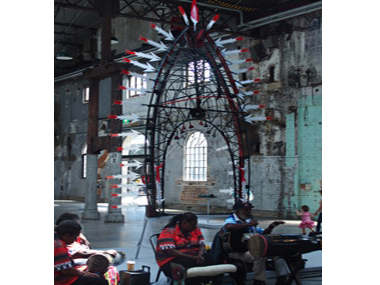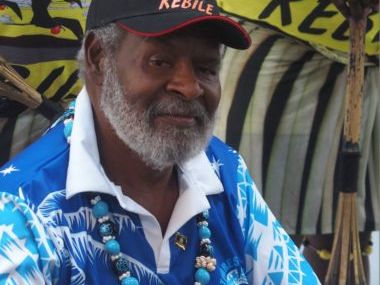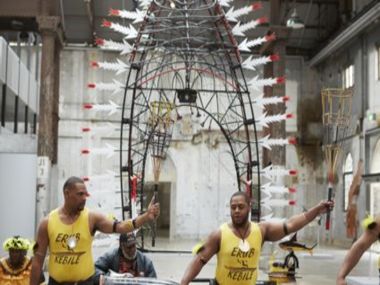THE TORRES STRAIT IN SYDNEY

Ken Thaiday Snr at Carriegeworks talking about his 4 metre artwork commissioned by the art centre.
Posted by Jeremy Eccles | 08.10.14
Dates:
03.10.14
: 23.11.14
Location: Carriageworks, 245 Wilson Street, EVELEIGH, NSW 2015
Ken Thaiday Snr. is an artist of rare talent whose works only infrequently make their way down south. So it's all the more exciting that Sydney is getting to see his largest ever work, specially commissioned by the dynamic Carriageworks art centre in Redfern. As visual arts czar Beatrice Grailton explained, “Ken's the perfect artist – working across media and at such a scale - for the multi-disciplinary space that we and the Performance Space operate here”. For Thaiday's work – mainly imaginative dance machines and dari, the feathered head-dress that appears on the Torres Strait flag, derive from the ceremonial traditions of his Erub Island homeland – covers the full gamut of the visual and performing arts.
The avuncular figure of Thaiday – born in 1950 – was in Sydney for the launch of his 4 metre high artwork – far too big to be worn by anyone but a giant! With him came family members to dance works especially choreographed for the occasion by Thaiday, while the women sang and played the giant drums that are essential accompaniment.
Around the central Dari-shaped dance machine – a network of cables in rubber tubes operating the over-sized carved wooden feathers that fringe the head-dress – is an exhibition of smaller head-dresses taking a variety of symbolic or wacky forms....a crayfish, a frigate bird, the Hammerhead Shark that is Thaiday's family totem, etc.
As his art practice has developed over time, Ken Thaiday's creations have become more spectacular and sculptural. His shark head-dresses, rising high above the dancers head and needing stabilising on the chest with a wire frame, are an awe-inspiring symbol of law and order - “boss of the saltwater”, as Thaiday calls the shark. The shark has a pivotal role in dance performances, swaying from side to side, a plume of white feathers around the jaws mimicking the foaming water of its feeding frenzy. The supernatural forces are appeased, their powers aligned with human activity by the rituals that attend this major ancestral totem.
Such tradition still strongly informs Thaiday's work, but his emphasis has now moved more towards exploring the aesthetic qualities of his creations.
While the Queensland Museum (and the British Museum which received the anthropologist Alfred Haddon's important collection in the early years of the 20th Century) is full of dance masks made from natural materials – turtle shells, bird feathers, human hair, etc; Thaiday will often use plastic, rubber, fibre-glass and wire to achieve his effects today.
The cultural resilience of the Torres Strait people has long depended upon this ability to accommodate and, after European colonisation, work with with imposed change. Mainlanders are often confused by the TSI mix of ancient ceremony and Christianity. But the so-called 'Coming of the Light' was welcomed there, Haddon was just in time to record traditional stories and save vital artefacts from the depradations of the missionaries, and the accommodation continues happily today – with artists like Ken Thaiday visiting the British and Queensland Museums to recover their past.
The question of adherence to strict tradition always poses a fine line for indigenous artists. They can risk being labelled as inauthentic. The veiled quest for a lost spirituality or a 'paradise lost', possibly sensed in the assuredness of traditional indigenous art, can demand conformity. Such issues are stirred when an artist seeks to experiment while still satisfying cultural requirements. Thaiday's work has contributed greatly to the affirmation of a strong cultural identity of Torres Strait Islanders, yet at the same time, in keeping with the sea-faring character, he has remained unfettered by tradition. He inhabits that nebulous territory between the traditional and the contemporary artist, showing us the excitement (and the technology) of invention as well as the grounding narrative of his cultural history. Both the old and the new provide the framework for his artistic creations that have been internationally appreciated and exhibited.
URL: http://www.carriageworks.com.au
Share this:
»  del.icio.us
»
del.icio.us
»  Digg it
»
Digg it
»  reddit
»
reddit
»  Google
»
Google
»  StumbleUpon
»
StumbleUpon
»  Technorati
»
Technorati
»  Facebook
Facebook
Contact Details

The artist at the launch of his massive dance machine

Dancers from Erub Island launch Ken Thaiday's artwork in Sydney
Further Research
Artists: Ken Thaiday Snr
News Tags: Carriageworks | dance machines | dari | Jeremy Eccles | Ken Thaiday | Torres Strait
News Categories: Australia | Blog | Exhibition | Feature | Industry | News
Exhibition Archive
- 10.10.17 | TARNANTHI 2017
- 11.08.17 | Natsiaas 2017
- 20.07.17 | APY ART DOMINATES THE WYNNE
- 17.07.17 | Anangu Artist Wins $100,000 Prize
- 14.07.17 | The End of AAMU
- 11.07.17 | ART ACROSS THE COUNTRY
- 11.07.17 | TARNANTHI IN OCTOBER
- 05.07.17 | TJUNGUṈUTJA - from having come together
- 13.06.17 | Ghost-Nets Straddle the World
- 07.06.17 | Grayson Perry Going Indigenous?
- 05.06.17 | Barks Bigger than Ben Hur
- 27.05.17 | NGA QUINQUENNIAL 2017
- 21.05.17 | Blak Douglas Finds Home at the NGA
- 21.05.17 | BRIAN ROBINSON WINS HAZELHURST WOP
- 18.05.17 | PARRTJIMA 2.0
Advertising

